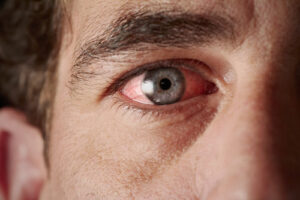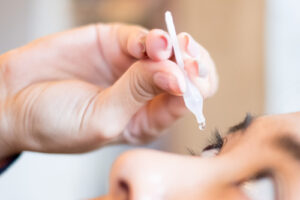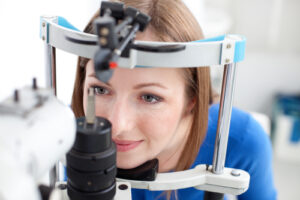Do your eyes often feel dry? Does it feel as though there’s always something in your eye?
These could be signs of dry eyes. Dry eyes can affect your vision, make it hard to perform simple, daily activities, and get in the way of enjoying everyday life.
Luckily there are various at-home treatments that can help with your dry eyes. Keep reading to learn more about dry eyes, home remedies for dry eyes, when to see an eye care professional, and the various treatment options available for dry eyes!
What is Dry Eye?
Dry eyes occur when your eyes produce poor-quality tears or don’t make enough tears. When you have dry eyes, you may experience the following symptoms:

- Itchiness
- Eye fatigue
- Light sensitivity
- Blurry or double vision
- Difficulty driving at night
- Burning or stinging sensation
- Trouble wearing contact lenses
- Stringy mucus around or in your eyes
- Feeling like there’s something in your eyes
Are There Home Remedies for Dry Eyes?
Although home remedies will not always be enough to resolve your dry eye symptoms, there are some things you may be able to do to help reduce them. Here are some tips for managing dry eyes at home:
Use Artificial Tears
Artificial tears lubricate your eyes, providing temporary relief from dry eyes. You may have to apply these eye drops multiple times throughout the day since the effects only last temporarily.
When buying over-the-counter artificial tears, look for preservative-free eye drops. That’s because eye drops with preservatives are more likely to irritate your eyes and worsen your symptoms.

Take Frequent Screen Breaks
Spending too much time in front of your computer, laptop, tablet, smartphone, or TV can lead to digital eye strain. You can combat eye strain and dry eyes from excessive screen time by following the 20-20-20 rule.
According to the rule, take a break from digital screens after every 20 minutes. Look at something at least 20 feet away for 20 seconds. Also, remember to blink often during your breaks. Blinking intentionally is a great way to lubricate your eyes and ease the symptoms of dry eyes.
Add Omega-3 Fatty Acids to Your Diet
Consider incorporating omega-3 fatty acids into your diet to aid with your dry eyes. Omega-3 fatty acids keep your eyes healthy and lubricated.
Some rich sources of omega-3 fatty acids include soybeans, walnuts, chia seeds, flaxseeds, and cold-water fish like salmon and tuna. Eating foods packed with omega-3 fatty acids can improve your tear quality and reduce your dry eye symptoms.
Stay Hydrated
Your tears are ninety-eight percent water. So ensure you remain hydrated throughout the day to help your eyes with tear production and alleviate your dry eye symptoms.
Aim to drink the recommended amount of six to eight glasses of water per day at intervals.

Invest in a Humidifier
Dry air can cause dry eyes. Using a humidifier in your home or office adds much-needed moisture, which can aid with the symptoms caused by a dry environment.
Wear Wraparound Sunglasses
Wraparound sunglasses protect your eyes from the sun and wind, which can exacerbate your dry eye symptoms. Ensure you get wraparound sunglasses that fit snugly without causing any discomfort.
When to See an Eye Doctor for Your Dry Eyes
At-home treatments usually help with dry eye symptoms. But if your symptoms become worse or persist even with at-home remedies, it’s time to see an eye care professional.
An experienced eye doctor can determine what’s causing your dry eye and provide the best treatment to relieve your dry eyes.

Your dry eye treatment options may include:
Prescription Eye Drops
There are many types of eye drops used for treating dry eyes. Xiidra and Restasis are two of the most commonly prescribed eye drops.
Both medications offer significant relief if you have moderate to severe dry eyes. It can take months before you really notice a difference when using Restasis.
On the other hand, Xiidra starts working within two weeks, but it takes about three months to experience its full effect.
Punctal Plugs
If your tears leave your eyes too quickly, causing dry eyes, your doctor may recommend punctal plugs. Punctal plugs are small, biocompatible devices implanted in your tear ducts or puncta to block drainage during a procedure called punctal occlusion.
Consequently, tears remain on the surface of your eyes longer and provide more lubrication, which significantly improves your dry eye symptoms. Punctal plugs can be temporary or permanent.
Temporary plugs dissolve on their own after several weeks. If temporary punctal plugs work well, your doctor may suggest permanent plugs.
Permanent plugs are made of acrylic or silicone and don’t dissolve. However, they can be removed if necessary.
Prokera
Prokera is a non-invasive device that is similar to a contact lens. It has anti-scarring and anti-inflammatory properties that help your eyes heal.
Prokera is made from two transparent, flexible rings that sandwich a tiny piece of amniotic membrane tissue. During the same-day procedure, your ophthalmologist starts by applying anesthetic drops. The numbing drops reduce any potential discomfort.
Your ophthalmologist will then insert Prokera over your cornea, similar to how a contact lens is placed. The amniotic membrane comes from a natural placenta and can help heal your cornea from dry eyes.
Find Lasting Relief from Dry Eyes
If at-home remedies don’t alleviate your dry eye symptoms, the experienced eye doctors at Sierra Nevada Eye Center can help. The doctors offer comprehensive dry eye treatment, including prescription drops, punctal occlusion, and Prokera for long-term relief from dry eyes.
Are you struggling with the frustrating symptoms of dry eyes? Schedule an appointment at Sierra Nevada Eye Center in Carson City, NV, today to find a lasting solution!


